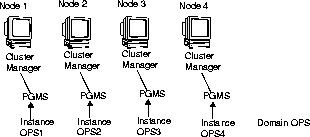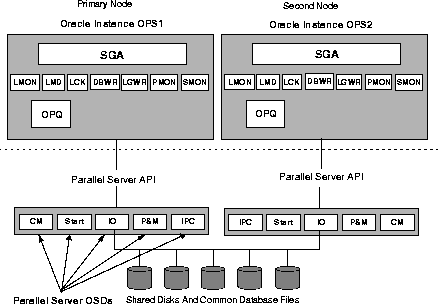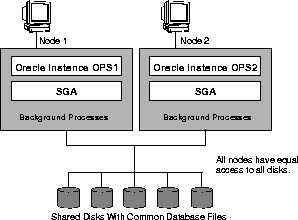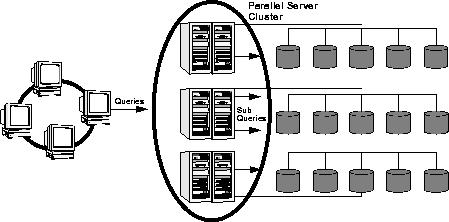Release 8.0.5 for Windows NT
A64425-01
Library |
Product |
Contents |
Index |
| Oracle
Parallel Server Getting Started
Release 8.0.5 for Windows NT A64425-01 |
|
This chapter provides a conceptual and component overview
of Oracle Parallel Server. This information helps you prepare and plan
your Oracle Parallel Server installation.
Specific topics discussed are:
Oracle Parallel Server is an architecture that allows multiple instances to access a shared database. Oracle Parallel Server offers the following (terms will be described later in this chapter):
An Oracle Parallel Server can handle node or disk failure in a clustered environment with no or minimal downtime. The Oracle Parallel Server architecture provides the following features:
Coordination of each node accessing the shared database provides the following:
The following components make up an Oracle Parallel Server:
| Component | Description |
|---|---|
|
Oracle8 Enterprise Edition |
Provides the applications and files to manage a database. All other Oracle Parallel Server components are layered on top of Oracle8 Enterprise Edition. |
|
Oracle Parallel Server Option Server |
Provides the necessary Oracle Parallel Server scripts and files to create and support an Oracle Parallel Server. This option also installs the Group Membership Service. |
|
Oracle Parallel Server Manager |
Provides a single point for starting, stopping, and monitoring the activity of parallel servers and parallel server instances from the command line or from within Oracle Enterprise Manager Console. Additional Information: See Chapter 6, "Installing and Configuring Oracle Parallel Server Manager", and "Managing Instances Using OPSM" in Chapter 7, "Administering Multiple Instances". |
|
Group Membership Service (PGMS) |
Monitors instances on nodes. PGMS is installed as a part of the Oracle Parallel Server Option. Additional Information: See the "Group Membership Service" subsection. |
|
Operating System Dependent (OSD) layer |
Consists of several software components developed by vendors. The OSD layer maps the key OS/cluster-ware services required for proper operation of Oracle Parallel Server. Additional Information: See the "Operating System Dependent Layer" subsection. |
The Group Membership Service (PGMS) called OraclePGMSService
on each node monitors what groups (or domains) are up and its instance
members. OraclePGMSService interacts with the Cluster Manager -- the vendor
software that manages access to shared disks and monitors the status of
various cluster resources (including nodes, networks, and the PGMS). The
Cluster Manager provides a node monitor service (as described in "Cluster
Manager" in this chapter), which each PGMS uses to determine the status
of PGMS instances on other nodes. Each instance attaches to the OraclePGMSService
during instance startup. An instance detaches from the OraclePGMSService
during shutdown. Figure 1-1 depicts how
PGMS coordinates between Cluster Manager and an instance.

A vendor-supplied Operating System Dependent (OSD) layer
that passed certification must be installed after Oracle Parallel Server
Option is installed. The OSD layer consists of several software components
developed by vendors. The OSD layer maps the key OS/cluster-ware services
required for proper operation of Oracle Parallel Server.
These components provide key services required for proper
operation of the Oracle Parallel Server Option and are used by various
clients, such as PGMS and Integrated Distributed Lock Manager (IDLM). Each
OSD module interacts with the Oracle Parallel Server runtime environment
as a single Dynamic Link Library (DLL). These components are more fully
described later in this chapter.
Figure 1-2 illustrates the
OSD components in a cluster with two nodes:

The Cluster Manager (CM) component:
It is critical that all Oracle Parallel Server instances
receive the same membership information when events occur. Notification
changes cause relevant Oracle Parallel Server recovery operations to be
initiated. If any node is determined to be dead or otherwise not a properly
functioning part of the system, CM terminates all processes on that node.
Thus, any process or thread running Oracle code can safely assume its node
is an active member of the system.
If there is a failure, recovery is transparent to user applications.
CM automatically reconfigures the system to isolate the failed node and
notify PGMS of the status. PGMS then notifies the IDLM. The IDLM subsequently
recovers any of the locks from the failed node. Oracle Parallel Server
can then recover the database to a valid state.
The IDLM relies on the Cluster Manager for timely and correct
information. If the IDLM cannot get the information it needs, it will shut
down the instance.
Oracle Parallel Server derives most of its functional benefits
from its ability to run on multiple interconnected machines. Oracle Parallel
Server relies heavily on the underlying Inter-Process Communication (IPC)
component to facilitate this.
IPC defines the protocols and interfaces required for the
Oracle Parallel Server environment to transfer reliable messages between
instances. Messages are the fundamental logical units of communication
in this interface. The core IPC functionality is built around an asynchronous,
queued messaging model. IPC is designed to send/receive discrete messages
as fast as the hardware allows. With an optimized communication layer,
various services can be implemented above it. This is how the IDLM carries
out all of its communication.
The Input/Output (IO) component provides interprocess capabilities
that a cluster implementation must support to enable proper operation of
the Oracle Parallel Server environment.
The Oracle Parallel Server environment is extremely dependent
on the ability of the underlying OS/cluster implementation to support simultaneous
disk sharing across all nodes that run coordinated Oracle Parallel Server
instances. Unlike switch-over based technologies, all Oracle Parallel Server
instances are active and can operate on any database entity in the shared
physical database simultaneously. It is this capability that gives Oracle
Parallel Server a large portion of its parallel scalability. It is the
role of the IDLM to coordinate the simultaneous access to shared databases
in a way that maintains consistency and data integrity.
At a high level, the Oracle Parallel Server shared I/O model
can be described as a distributed disk cache implemented across all nodes
that define the Oracle Parallel Server cluster. The core of Oracle Parallel
Server can be viewed as a major client of the cache. Disk blocks from the
shared devices are read into a particular node instance cache only after
mediation by the IDLM. The other node instance may read the same blocks
into its cache and operate on them simultaneously. Updates to those blocks
are carefully coordinated. In general, all shared disk based I/O operations
are mediated by the IDLM. The set of distributed IDLMs on each node can
be thought of as managing the distributed aspects of the cache.
Disk update operations must be carefully coordinated so that
all nodes see the same data in a consistent way. Any Oracle Parallel Server
instance intending to update a cached data block must enter into a dialog
with the IDLM to ensure it has exclusive right to update the block. Once
it does this, the instance is free to update the block until its rights
have been revoked by the IDLM. When the exclusive update right is revoked,
the instance with block updates must write the block to disk so that the
other node can see the changes. Given this rather high-level view of the
IDLM I/O consistency model, it is clear that disk blocks can migrate around
to each instance's block cache and all updates are flushed to disk when
an instance other than the owner desires access to the block. It is this
property that directly determines the reliance of Oracle Parallel Server
on shared disk implementations.
The Startup (START) component initiates the Oracle Parallel
Server components in a specific order during instance startup. It is up
to the vendor to determine this startup sequence.
The Performance and Management (P&M) component defines
the way Oracle Parallel Server clients are configured and the relevant
information an OSD implementation must provide to allow the Oracle management
tools to operate properly. The P&M component also defines the way OSD
modules provide performance analysis information suitable for OPSM.
Oracle Parallel Server instances coordinate with the following
components:
Oracle Parallel Server allows multiple instances to coordinate
data manipulation operations on a common database. An Oracle Parallel Server
instance is defined as a process and a set of threads and memory
structures required for proper database operation. The pool of threads
that make up an instance coordinate their work on the database through
shared memory by means of the instance Shared Global Area (SGA). Users
can connect to any instance to access the information that resides within
the shared database.
The database files are located on disk drives that
are shared between the multiple nodes. If one node fails, client applications
(written to do so) can re-route users to another node. One of the surviving
nodes automatically performs recovery by rolling back any incomplete transactions
that the other node was attempting. This ensures the logical consistency
of the database.
|
Note: An instance does not include database files. This means you can start up an instance without mounting the database files. |
Each instance has a unique:
Different instances on different nodes can have the same
system ID (SID). Oracle Corporation recommends each node in the domain
having a unique SID to identify its instance. For example, the first node,
called the primary node, uses the SID OPS1; the second node uses
the SID OPS2 to identify its instance; and so on.
All nodes have the same components. The primary node is simply just the first node in cluster.
All instances share:
An instance contains:
| Additional
Information:
For more information on Oracle8 database processes and memory structures, see Oracle8 Concepts. |
A database is logically divided into tablespaces that contain
all data stored in the database. Tablespaces, in turn, are made up of one
or more data files.
With Oracle Parallel Server, all participating instances
access the same database files.
Figure 1-3 shows the relationship
between two Oracle instances and the shared disks on which the database
files are stored:

Oracle Parallel Server has the following features:
| Feature | Description |
|---|---|
|
Integrated Distributed Lock Manager (IDLM) |
Maintains a list of system resources and provides locking mechanisms to control allocation and modification of Oracle resources. Every process interested in the database resource protected by the IDLM must open a lock on the resource. Additional Information: See the "Integrated Distributed Lock Manager" subsection. |
|
Parallel Cache Management (PCM) |
Provides instance locks (with minimal use of the IDLM) that cover one or more data blocks of any class: data block, index blocks, undo blocks, segment headers, and so on. Oracle Parallel Server uses these instance locks to coordinate access to shared resources. The IDLM maintains the status of the instance locks Additional Information: See the "Parallel Cache Management" subsection. |
|
Oracle Parallel Query (OPQ) |
Ships queries between nodes so that multiple nodes can execute on behalf of a single query. Additional Information: See the "Oracle Parallel Query" subsection. |
The Integrated Distributed Lock Manager (IDLM) maintains
a list of system resources and provides locking mechanisms to control allocation
and modification of Oracle resources. Resources are structures of
data. The IDLM does not control access to tables or anything in the database
itself. Every process interested in the database resource protected by
the IDLM must open a lock on the resource.
Oracle Parallel Server uses the IDLM facility to coordinate
concurrent access to resources, such as data blocks and rollback segments,
across multiple instances. The Integrated Distributed Lock Manager facility
has replaced the external Distributed Lock Manager which was used in earlier
releases of Oracle Server.
The IDLM uses the LMON and LMDn processes. LMON manages
instance and processes deaths and associated recovery for the IDLM. In
particular, LMON handles the part of recovery associated with global locks.
The LMDn process handles remote lock requests (those which originate
from another instance).
The IDLM:
The IDLM is a resource manager and, thus, does not
control access to the database.
A node in a cluster needs to modify block number n
in the database file. At the same time, another node needs to update the
same block n to complete a transaction.
Without the IDLM, both nodes update the same block
at the same time. With the IDLM, only one node is allowed to update the
block. The other node must wait. The IDLM ensures that only one instance
has the right to update a block at any one time. This provides data integrity
by ensuring that all changes made are saved in a consistent manner.
The IDLM uses PGMS to determine which instances are active.
When the instance is started, the LMON and LMDn processes are started
and the IDLM registers with PGMS. The IDLM deregisters with PGMS when the
database is shutdown.
Parallel Cache Management (PCM) provides instance locks (with
minimal use of the IDLM) that cover one or more data blocks of any class:
data block, index blocks, undo blocks, segment headers, and so on. Oracle
Parallel Server uses these instance locks to coordinate access to shared
resources. The IDLM maintains the status of the instance locks.
PCM locks ensure cache coherency by forcing instances to
acquire a lock before modifying or reading any database block. PCM locks
allow only one instance at a time to modify a block. If a block is modified
by an instance, the block must first be written to disk before another
instance can acquire the PCM lock, read the block, and modify it.
If node 1 needs access to data that is currently in node
2's buffer cache, node 1 can submit a request to the IDLM. Node 2 then
writes the needed blocks to disk. Only then is Node 1 notified by the IDLM
to read updated and consistent data from the disk.
You use the initialization parameter GC_FILES_TO_LOCKS to
specify the number of PCM locks which cover the data blocks in a data file
or set of data files. The smallest granularity is one PCM lock per data
block; this is the default. PCM locks usually account for the greatest
proportion of instance locks in a parallel server.
PCM locks are implemented in four ways:
|
Additional Information: See Chapter 9, Parallel Cache Management Instance Locks" and Chapter 15, "Allocating PCM Instance Locks", of the Oracle8 Parallel Server Concepts and Administration guide. It is possible to have both fine-grain locking and hashed locking enabled at the same time. |
Below is a comparison of both
PCM locks:
| Hash PCM Locks | Fine-Grain PCM Locks |
|---|---|
|
|
Use the table below to choose a PCM lock:
| When to use hashed locks... | When to use fine-grain locks... |
|---|---|
|
|
With the Oracle Parallel Query (OPQ), Oracle can divide the
work of processing certain types of SQL statements among multiple query
server processes.
When parallel execution is not being used, a single server
thread performs all necessary processing for the sequential execution of
a SQL statement. For example, to perform a full table scan (such as SELECT
* FROM EMP), one thread performs the entire operation.
OPQ performs the operations in parallel using multiple parallel
processes. One process, known as the parallel coordinator, dispatches
the execution of a statement to several parallel server processes
and coordinates the results from all the server processes to send the results
back to the user.
The parallel coordinator breaks down execution functions
into parallel pieces and then integrates the partial results produced by
the parallel server processes. The number of parallel server processes
assigned to a single operation is the degree of parallelism for an operation.
Multiple operations within the same SQL statement all have the same degree
of parallelism
Oracle Parallel Server provides the framework for the Parallel
Query Option to work between nodes. The OPQ behaves the same way in Oracle
with or without the Parallel Server Option. The only difference is that
Oracle Parallel Server enables OPQ to ship queries between nodes so that
multiple nodes can execute on behalf of a single query. Here, the server
breaks the query up it into smaller operations that run against a common
database which resides on shared disks. Because it is performed by the
server, this parallelism can occur at a low level of server operation,
rather than at an external SQL level.
In some applications, an individual query often consumes
a great deal of CPU resource and disk I/O (unlike most online insert or
update transactions). To take advantage of multi-processing systems, the
data server must parallelize individual queries into units of work which
can be processed simultaneously.
If the query were not processed in parallel, disks would
be read serially with a single I/O. A single CPU would have to scan all
rows in a table. With the query parallelized, disks are read in parallel,
with multiple I/Os.
Several CPUs can each scan a part of the table in parallel,
and aggregate the results. Parallel query benefits not only from multiple
CPUs but also from greater I/O bandwidth availability.
OPQ can run with or without the Oracle Parallel Server. Without
the Oracle Parallel Server option, OPQ cannot perform multi-node parallelism.
Oracle Parallel Server optimizes Oracle8 Enterprise Edition running on
clustered hardware, using a parallel cache architecture to avoid shared
memory bottlenecks in OLTP and decision support applications.

OPQ within Oracle Parallel Server performs parallelism within
a node and among nodes via the parallel query slave processes on each node.
A sample SQL statement is shown below:

After you have run a query, you can use the information derived
from V$PQ_SYSSTAT to view the number of slave processes used, and other
information for the system.
|
Additional Information: See Chapter 22, "Parallel Execution", of the Oracle8 Concepts guide. |